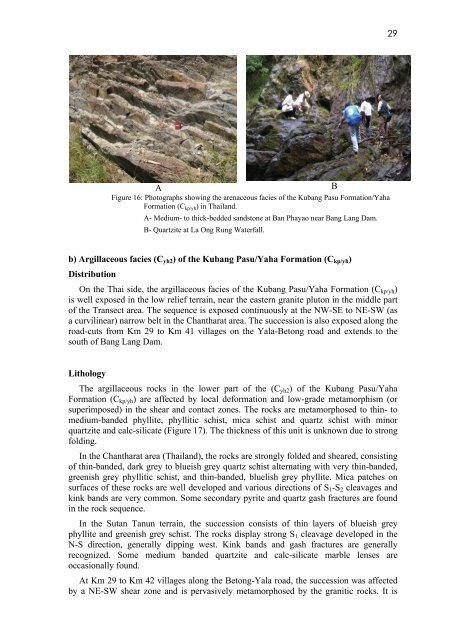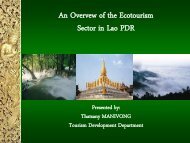GEOLOGY OF THE PENGKALAN HULU-BETONG TRANSECT ...
GEOLOGY OF THE PENGKALAN HULU-BETONG TRANSECT ...
GEOLOGY OF THE PENGKALAN HULU-BETONG TRANSECT ...
You also want an ePaper? Increase the reach of your titles
YUMPU automatically turns print PDFs into web optimized ePapers that Google loves.
A<br />
Figure 16: Photographs showing the arenaceous facies of the Kubang Pasu Formation/Yaha<br />
Formation (Ckp/yh) in Thailand.<br />
A- Medium- to thick-bedded sandstone at Ban Phayao near Bang Lang Dam.<br />
B- Quartzite at La Ong Rung Waterfall.<br />
b) Argillaceous facies (Cyh2) of the Kubang Pasu/Yaha Formation (Ckp/yh)<br />
Distribution<br />
On the Thai side, the argillaceous facies of the Kubang Pasu/Yaha Formation (Ckp/yh)<br />
is well exposed in the low relief terrain, near the eastern granite pluton in the middle part<br />
of the Transect area. The sequence is exposed continuously at the NW-SE to NE-SW (as<br />
a curvilinear) narrow belt in the Chantharat area. The succession is also exposed along the<br />
road-cuts from Km 29 to Km 41 villages on the Yala-Betong road and extends to the<br />
south of Bang Lang Dam.<br />
Lithology<br />
The argillaceous rocks in the lower part of the (Cyh2) of the Kubang Pasu/Yaha<br />
Formation (Ckp/yh) are affected by local deformation and low-grade metamorphism (or<br />
superimposed) in the shear and contact zones. The rocks are metamorphosed to thin- to<br />
medium-banded phyllite, phyllitic schist, mica schist and quartz schist with minor<br />
quartzite and calc-silicate (Figure 17). The thickness of this unit is unknown due to strong<br />
folding.<br />
In the Chantharat area (Thailand), the rocks are strongly folded and sheared, consisting<br />
of thin-banded, dark grey to blueish grey quartz schist alternating with very thin-banded,<br />
greenish grey phyllitic schist, and thin-banded, bluelish grey phyllite. Mica patches on<br />
surfaces of these rocks are well developed and various directions of S1-S2 cleavages and<br />
kink bands are very common. Some secondary pyrite and quartz gash fractures are found<br />
in the rock sequence.<br />
In the Sutan Tanun terrain, the succession consists of thin layers of blueish grey<br />
phyllite and greenish grey schist. The rocks display strong S1 cleavage developed in the<br />
N-S direction, generally dipping west. Kink bands and gash fractures are generally<br />
recognized. Some medium banded quartzite and calc-silicate marble lenses are<br />
occasionally found.<br />
At Km 29 to Km 42 villages along the Betong-Yala road, the succession was affected<br />
by a NE-SW shear zone and is pervasively metamorphosed by the granitic rocks. It is<br />
B<br />
29



